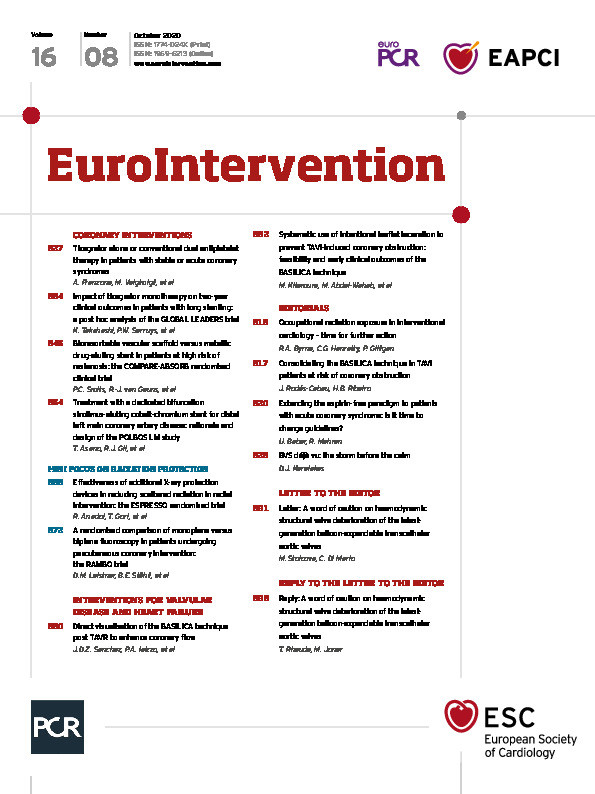We read with interest the Letter to the Editor by Drs Stolcova and Di Mario1 regarding our article “Predictors of haemodynamic structural valve deterioration following transcatheter aortic valve implantation with latest-generation balloon-expandable valves”2. The authors give an introduction to the study and also summarise the main findings of a separate study published in the same issue of EuroIntervention pertaining to assessment of the SAPIEN 3 Ultra transcatheter heart valve3.
The main issue raised by the authors relates to the seemingly misinterpreted consequence of elevated transvalvular gradients by transthoracic echocardiography in 691 patients according to the recently published EAPCI/ESC/EACTS standardised definitions of structural valve deterioration (SVD) and valve failure4. In our study, the prevalence of elevated gradients was 10.3% during 12-month follow-up after transcatheter aortic valve replacement (TAVR), fulfilling the above-mentioned criteria of moderate or greater haemodynamic SVD ([I] mean transvalvular gradient ≥20 mmHg or [II] mean transvalvular gradient increase ≥10 mmHg compared with previous measurements after TAVR). Yet, the authors emphasise that SVD requires the presence of permanent intrinsic changes of the valve. In this respect we agree with the authors. Nevertheless, the recent EAPCI/ESC/EACTS standardised definitions also state that “The diagnosis is based on permanent haemodynamic changes in valve function assessed by means of echocardiography, even without evidence of morphological SVD” when it comes to the definition of haemodynamic SVD (see Capodanno et al, page 5)4. As proposed by the consensus statement, integration of other imaging modalities, such as transoesophageal echocardiography and/or computed tomography, was applied at the discretion of the treating physician to rule out valve thrombosis as a potentially reversible cause of valve dysfunction.
Consequently, we do not disagree with the authors regarding the discussion about permanent intrinsic changes of the valve as a mandatory requirement for SVD after TAVR, and yet need to point out that there is nothing wrong with any of the definitions applied in our study, nor with the analysis performed subsequently. It was our well-defined intention to study elevated transvalvular gradients as assessed by transthoracic echocardiography in accordance with current EAPCI/ESC/EACTS standardised definitions in order to investigate the prevalence of this parameter suggestive of haemodynamic SVD. As a matter of fact, the standardised definitions of SVD aimed to unify the plethora of prior definitions used to detect deterioration of valve function in most recent trials and registries. Most importantly, cardiac computed tomography angiography (CCTA) imaging substudies of larger randomised trials suggested the presence of (sub-) clinical leaflet thrombosis as a matter of concern in patients undergoing TAVR5,6. Against this background, haemodynamic SVD was introduced to identify patients at increased risk for (sub-) clinical leaflet thrombosis. Along these lines, it is not expected that obvious permanent intrinsic changes to the leaflet tissue by transthoracic echocardiography will be observed within the first year after TAVR. Yet, increased transvalvular gradients may be observed and considered an early sign of SVD, even in the absence of morphological abnormalities. It was our intention to investigate this phenomenon as there is logic for smooth transition between subclinical and clinical leaflet thrombosis. It has to be stressed that patients with elevated transvalvular gradients immediately after TAVR were excluded from our study and are probably the result of patient-prosthesis mismatch. Bioprosthetic valve thrombosis, which requires symptomatic presentation of the patient, was observed in only 0.87% of patients in our study and in 8.5% of patients with haemodynamic SVD, suggesting a significant clinical gap between asymptomatic patients with isolated elevated transvalvular gradients and the clinical syndrome of bioprosthetic valve thrombosis. Hence, future studies are required to address this critical phase of transition between SVD and bioprosthetic valve failure.
In everyday practice, transthoracic echocardiography represents the only means to monitor change in transvalvular gradients over time after TAVR. This is the reason why these renowned societies came together to establish standardised definitions to be applied in controlled studies and clinical practice. Consequently, it is not a question of belief (as the authors suggest), but rather the result of thorough scientific conduct to investigate the prevalence of such a definition in a large registry reflecting real-world practice.
Conflict of interest statement
M. Joner reports personal fees from Biotronik, personal fees from OrbusNeich, grants and personal fees from Boston Scientific, grants and personal fees from Edwards Lifesciences, personal fees from AstraZeneca, personal fees from Recor and grants from Amgen. T. Rheude has no conflicts of interest to declare.
Supplementary data
To read the full content of this article, please download the PDF.

